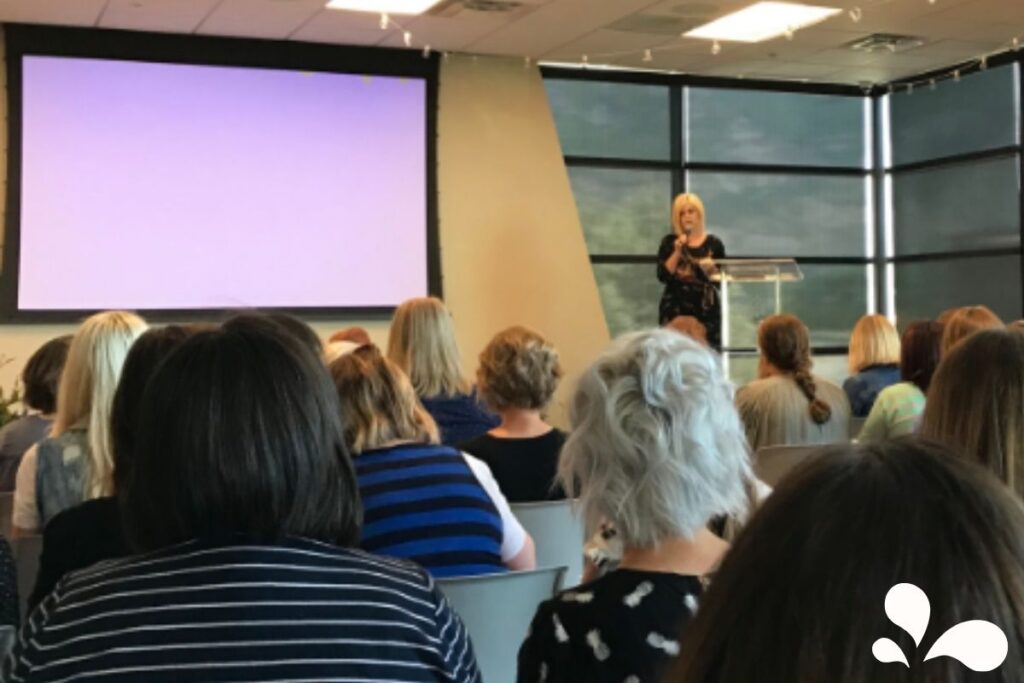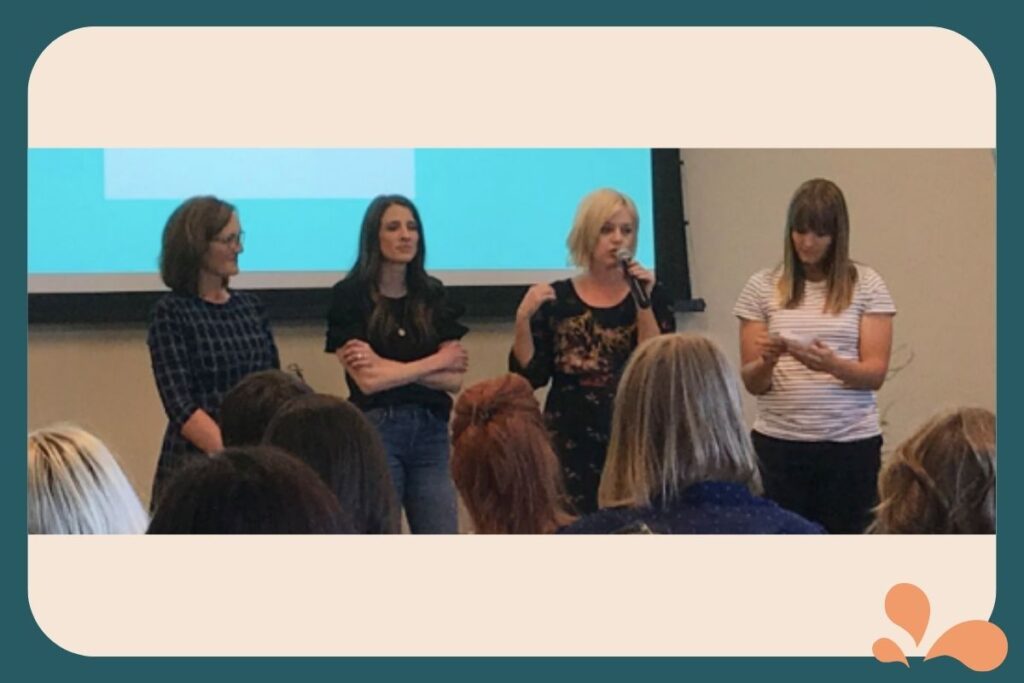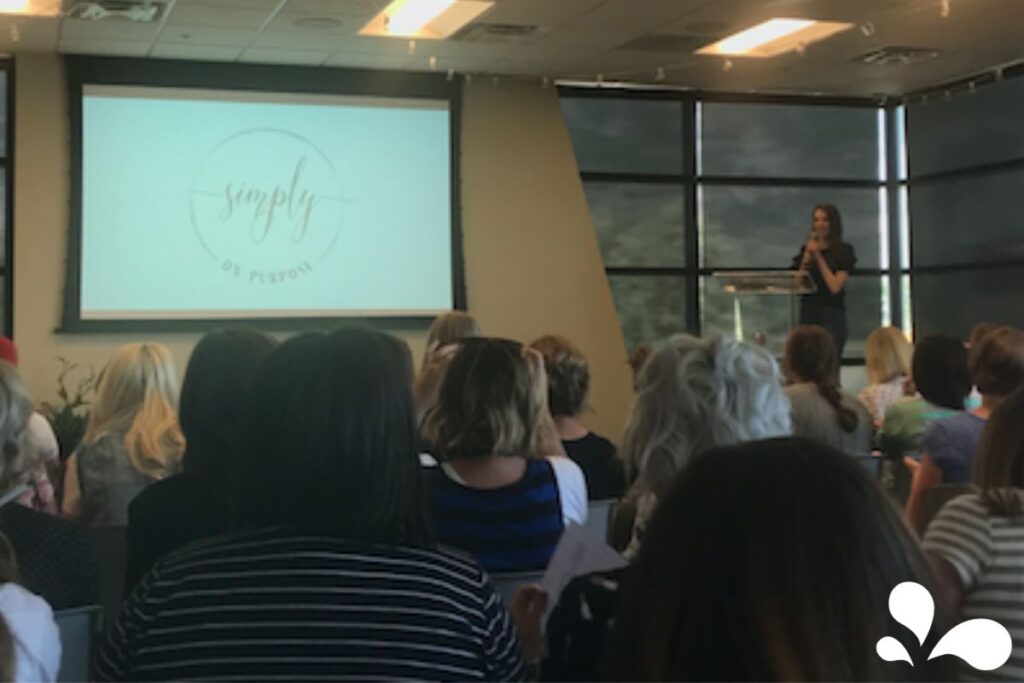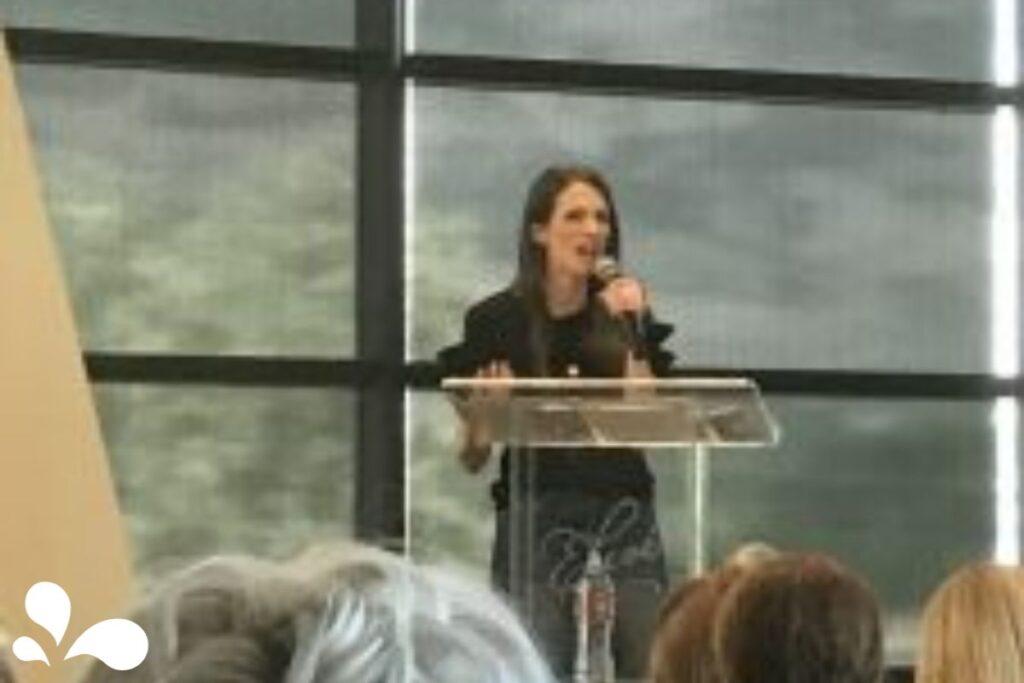Part 1 – Thoughts & Emotions
I recently attended the Thriving Mom Conference in Utah County put on by Lisa Andersen of Thriving Motherhood. Lisa was joined by Jody Moore, Georgia Anderson, and Ralphie Jacobs to speak about motherhood and what we can do to feel confident and thrive in our parenting.
The conference focused on 3 Guiding Principles:
- Managing your thoughts
- Learning and applying parenting techniques and tools
- Managing your time
In the next 4 sections I am going to share with you what I learned from these amazing women.
what I learned from Jody Moore.
Jody is a Certified Life Coach, podcaster, momologist, speaker, mother, and wife. You can find her at her website: Jody Moore Coaching, her podcast: Better Than Happy, and her Instagram @jodymoorecoaching. She talked about emotions. She said that your emotions come from your thoughts and that you can work to change those thoughts to be positive so that you can have positive emotions vs negative emotions.
Your brain is very powerful, and for some reason it makes you believe that “you are going to die” in hard situations or if you do something new. The truth is that “the worst thing that can happen is a negative emotion.” The worst-case scenario is that you end up sad, embarrassed, mad, frustrated, overwhelmed, or so many other negative emotions. And negative emotions are “not that big of a deal.”
Don’t fear negative emotion
When you feel an emotion you have 3 options on how to deal with it. Those include:
- Resisting
- Avoiding
- Processing/Feeling
If you choose to Resist emotion, the emotion actually intensifies. Resisting emotion can lead to other problems, including health problems.
Avoiding emotion causes you to do things to try to escape those emotions. You may try to escape by eating (chocolate, carbs, or junk food), shopping, or getting on social media because these things give your brain a small amount of dopamine and boosts your mood. However, this boost is temporary, and your behaviors of avoiding can actually add more negative emotions to your plate.
By Processing your emotions, you allow your body to feel. You acknowledge that it is there. You find it, and then you can let it go. You need to be able to master this skill and help your children do the same thing.
“Feeling negative emotion is required if you want to live an amazing life.”

The future and beliefs
Jody talked about the future and how you need to keep thinking about your future. When you are little you think about our future all the time. You think about your career choices, you think about finding an amazing man to marry, you think about how many children to have, about living in an amazing house, etc. As you get older and as those things actually happen, you tend to stop thinking about the future.
However, thinking about the future brings excitement. Without excitement you feel dead inside. When you plan a vacation, you naturally think about the future, and you get excited about it. You need to think about your future in the same way. Let your thoughts become reality. Your brain is going to tell you that you can’t, don’t believe it. When you have a thought to take an adult ballet class, DO IT, don’t let your brain tell you that you can’t because you don’t know how to dance.
I took an adult ballet class this spring and it was amazing. It was full of moms with different levels of dance background from none to those who have danced their whole life. We didn’t compare ourselves to each other and we lifted each other up in learning a new skill. It was fun and it was great self care for me.
The same thing applies to you and your thoughts. If you want to try something new, DO IT. Believe in yourself and think positively. Jody said that, “a belief is a thought that you keep thinking,” and that “belief is what creates your current reality.”
Parenting and thoughts/emotions
From what I’ve shared so far, you may be wondering what this has to do with parenting. It has EVERYTHING to do with parenting.
If your child does something, whether it is good or bad, you have thoughts about it. And those thoughts create an emotion. That emotion can then affect the way you act towards that child and throughout the day.
Jody shared an experience that she had. She would wake up irritated each morning that her kids had climbed into bed with her and her husband during the night. She said that she would go to bed, and several hours later wake up to see her 2-year-old in bed with them and she would think, “This is ridiculous!” She would go back to sleep and several hours later wake up again to see that her 4-year-old had joined in too. She would again think, “This is ridiculous!” A couple hours later she would wake up to the cat adding to the mix and think, “This is ridiculous!” Then she would wake up in the morning and wonder why she was to irritated and frustrated in the morning.
Her husband one day said to her that he felt like their bed was a “Magic Show.” And that it was “magic” that their kids kept appearing throughout the night. He was looking at it in a positive way, having positive thoughts, and therefore positive emotions.
You can do the same thing when your child behaves negatively. Force your brain to think a positive thought such as, “They are leaning and I can help them.” Instead of a negative thought such as, “Why did they do that again!” This positive thought will help you to have a positive emotion which will help your child in a positive manner. This will take practice.
Changing your thoughts is to look at people with love rather than trying to change them. This includes looking at yourself with love.

You matter
Jody explained that, “Your emotional health affects your kids more than whether you work or stay at home.”
Your emotional health affects you and those around you more than you think.You matter. You being happy matters. You can’t help anyone until you have helped yourself.
You can do hard things. What you believe matters. You are enough, don’t let your brain tell you otherwise.
You are ALWAYS, and have always been, 100% worthy, lovable, and enough.
Jody shared so many wonderful things. I am excited to be able to share them with you. Make sure to check her out on her website, her podcast, and on Instagram and share everything you learn with those you care about.
I hope that my sharing what I have learned will help you as a woman and mother. I hope that by learning about thoughts and emotions you feel more empowered and confident to think about the future and to do new things.
You are powerful. I hope this article has helped you recognize the power that you already have within, and that you will join me in spreading that recognition to everyone you know.

Part 2 – Transition and Self Care
Here is what I have learned from Georgia Anderson.

Transitioning and preparing for launch
Georgia Anderson is a family educator, massage therapist, doula, mother, step-mother, grandmother, skier, hiker, and adventurer. You can find her at her website: Georgia Anderson Coachinn or on Instagram: @georgiaandersoncoaching. She talked about preparing for launch and life’s best after party, meaning we need to prepare ourselves and our children for the time that they will leave and the time we will no longer have children at home (the after party).
Georgia focused on 3 things:
- Transition
- Agendas
- Maintaining Self
Transition
“Ultimately we need to be able to Let Go.” You want your children to feel like they can go out and try new things and make decisions for themselves. And you need to be the safety net that they can come back to.
She talked about how you spend a lot of time planning your wedding and your births. You spend less time figuring out your day-to-day with marriage and raising children. And you spend even less time figuring out what happens after your children are gone.
All of these are major transitions and need to be thought about. Just like Jody Moore–see Part 1 above, you need to think about your future and create plans to look forward to with excitement. When you plan the transitions they go a lot more smoothly.
Agendas
She had us think about our tendencies, strengths, and weaknesses when it comes to these areas:
| Focusing on mistakes | Building on strengths |
| Expecting too little | Showing confidence |
| Expecting too much* | Valuing the child as-is |
| Overprotecting/pampering | Stimulating independence |
*She said that there is nothing wrong with high expectations as long as we are also valuing the child as they are. She recommended the book Grit by Angela Duckworth and said that it is explained that “wise” parents are both demanding and supportive.

When her kids were younger she set a rule in their house that each child had to play a musical instrument until they were at least 12-years-old, at which point they could choose to continue or stop. She said that she wanted her kids to have something hard to do everyday, and since they didn’t have a cow to milk she chose to have them play an instrument.
This worked well for her first child. Her second child was more stubborn and when he was 10 he decided that he didn’t want to play the piano anymore and he stopped practicing. This was hard for Georgia because it went against her plan and she couldn’t let him ruin her plan for her other children and because “he was really good.” So, she would make him sit in front of the piano until he touched the keys, which was sometimes hours.
Finally she decided that if he wasn’t going to practice that she wasn’t going to pay for lessons anymore and called his piano teacher to regretfully inform him that her son was quitting. He talked to and they came up with a plan for him to teach her son music theory and music history and drop the focus of playing the piano. So, until her son was 12 he continued to take piano lessons. He did not touch the piano from the time he was 10 to the time he was 17.
This experience taught Georgia said that she needed to stop having agendas. Each child is different and you can’t expect them to happily walk through your plan all the time. She realized that she needed to “Drop the agenda.”

Maintaining self
I was very touched when she talked about maintaining self.
She said that “the best thing that you can give your children and family is to know who you are and love yourself.” You do that through self care. Georgia calls the things you do for self care “constants.” She asked us to write down the “constants” in our life that feed our soul. “Constants” will be different for everyone and may include things like being in nature, listening to/playing music, a spiritual practice, taking a bubble bath, yoga, painting, etc.
If you feel lost and you don’t have any “constants” in your life then start experimenting. She said to take at least 5 minutes a day and read something good or listen to a podcast. Start with that and play around with things that peak your interest (and don’t let negative thoughts turn you away from trying new things – from Jody Moore–see Part 1 above). And notice the times when you feel joy and do those things more often. Find yourself and love who you are.
When we know who we are and love ourselves we become a safe place, not only for ourselves but for our children. If they have a safe place to come back to they are able to separate more easily, and we are more able to allow them to separate. We can let the baby bird leave the nest.
On Children
She closed with this poem and I wanted to share it with you.
On Children by Kahlil Gibran
Your children are not your children.
They are the sons and daughters of Life’s longing for itself.
They come through you but not from you,
And though they are with you, yet they belong not to you.
You may give them your love but not your thoughts.
For they have their own thoughts.
You may house their bodies but not their souls,
For their souls dwell in the house of tomorrow,
which you cannot visit, not even in your dreams.
You may strive to be like them, but seek not to make them like you.
For life goes not backward nor tarries with yesterday.
You are the bows from which your children as living arrows are sent forth.
The archer sees the mark upon the path of the infinite,
and He bends you with His might that His arrows may go swift and far.
Let your bending in the archer’s hand be for gladness;
For even as He loves the arrow that flies,
so He loves also the bow that is stable.

What Georgia shared was beautiful and amazing. I am glad to be able to share it with you. Make sure to check her out on her website and on Instagram and share everything you learn with those you care about.
I hope that my sharing what I have learned will help you as a woman and mother. I hope that by learning about preparing for the launch and life’s best after-party you feel more empowered and confident in yourself and raising your children.
You are powerful. I hope this article has helped you recognize the power that you already have within, and that you will join me in spreading that recognition to everyone you know.

Part 3 – Purposeful Parenting
Here is what I have learned from Ralphie Jacobs.

Parenting with purpose
Ralphie Jacobs is a mom of four girls, a believer of kitchen dance parties, a teacher of creating a life full of purpose, and a peanut M&M lover. You can find her on Instagram @simplyonpurpose – IG. Ralphie talked about parenting with purpose.
Often you use fear as a guiding principle in our parenting. You tell your children that if they don’t clean up their toys they can’t play with their friends. Fear works, however it is short term. Fear does not produce real change and it does not teach them “to love what is right.”
She shared her simple formula for parenting with purpose. You must:
- Model happiness
- Teach your children
- Look for the good
Doing these things takes effort. And it takes a change of perspective and a change of attitude. “Parenting is a learned skill.” It is not something that you suddenly know how to do as soon as you become a parent, it doesn’t work that way. It’s something that takes practice.
Model happiness
So, how do you “model happiness?” Ralphie taught that you need to model being happy in three areas. These are 1. being happy with yourself, 2. being happy with people smaller than you (ie. children), and 3. being happy with peers. This means that you don’t put ourselves down, you don’t treat your children or other children negatively, and you don’t act negatively to the people around you daily (like the person that cut you off on the freeway).
“Actions speak louder than words” and if you want your children to be happy and know how to be happy in difficult situations you need to be that example. This doesn’t mean that you are always happy. Life is not always happy. However, if in the difficult times of your life, or your children’s lives, you can act positively and show them how to work through the sad, frustrating, angry things, it will help your children learn those skills.
“Don’t cause childhood behavior to cause you to misbehave as an adult.”

Teach your children
What is the best way to teach your children to behave? Discipline. Discipline means to teach, it comes from the word disciple which means to be a follower or student of a teacher. Ralphie shared that the best way to discipline is positive reinforcement.
“Research has shown that the most effective way to reduce problem behavior in children is to strengthen desirable behavior through positive reinforcement rather than trying to weaken undesirable behavior through negative processes.” – Dr. S.W. Bijou, International Encyclopedia of Education
Positive reinforcement helps to motivate children to do things and teaches them to love what is right (behaving well). It means changing “don’ts” into “do’s.” Because don’ts equal “I am no fun” and you want to be fun and model happiness. So rather than saying “don’t …” redirect them to something they can do.
If you are in my shoes and have children between 0 to 4 years old then redirection is going to become your best friend. Ralphie taught that for children four years old and younger to use very little punishment, a lot of redirection, and a lot of role-playing.
Here is a video of her doing a role-play with a volunteer so that you can see an example of what she means.
She said that role-playing can be used for all ages and that her teenager still likes to do it to work through difficult situations that are coming before they happen.
Look for the good
Parents tend to pay more attention to bad behavior than positive behavior. Giving attention to negative behaviors causes children to add those behaviors to a list of things to do to get your attention. Therefore, the way you get children to behave well is to pay attention to the positive behaviors that they do and to use positive reinforcement.
Researchers have found that 80% of bad behaviors will go away by paying attention to the positive. Ralphie said to go out of your way to acknowledge positive behavior. This means taking time to walk to the playroom, poke your head in, and tell your children that you are so proud of the way that they are playing nicely together. This doesn’t have to take a lot of time and she said that it shouldn’t take more than 12 seconds because you don’t want to take away from their playtime.
When a child is acting out pay attention to and acknowledge positive behaviors in them and the other children around them. Ralphie shared a story about running errands with her children and one of them being really unhappy and disruptive at the grocery store. Rather than giving that child attention for her negative actions she gave attention to her other children for their positive actions. She stated that by the end of the time at the store her unhappy daughter had changed her attitude, bought her mom peanut M&M’s (her favorite), and apologized for her behavior. She said that “you can be respectful without being respected.”
By paying attention to the positive and looking through the “weeds” and picking the “flowers” it helps children to change their behavior much more quickly than when you react negatively to it.

You are human
Most of all remember that your children are human, just like you are. There are some days that you can’t handle doing certain things and your children will be the same way. Don’t confuse “can’t” with “won’t” and realize that sometimes just because your child could do something last week does not mean that they can do it today (they may not mentally be able to handle it). And that is ok. Work with them, model the behavior, teach the behavior, and praise the behavior.
What Ralphie shared was so inspiring and taught me so much. I am glad to be able to share it with you. Make sure to check her out on Instagram and share everything you learn with those you care about.
I hope that my sharing what I have learned will help you as a woman and mother. I hope that by learning about parenting with purpose you feel more empowered and confident in yourself and raising your children.
You are powerful. I hope this article has helped you recognize the power that you already have within, and that you will join me in spreading that recognition to everyone you know.

Part 4 – Lisa Andersen
Here is what I have learned from Lisa Andersen:

What is time-mapping?
Lisa Andersen is a mother who encourages other mothers to find more joy and purpose in raising children. She taught about time-mapping, which is exactly what it sounds like – mapping out your time every day.
Time-mapping will:
- Help you to manage the expectations you have for yourself
- Increase the likelihood of “me time” (self care)
- Help you build relationships (with your children, spouse/partner, and others)
Time-mapping gives you an hour-by-hour breakdown of when you will do the things that you need to do versus a to-do list that is a never-ending list of things that you should do.
By planning your day by the hour, or half hour, you can create a plan to get the things done that you need to do, and then filter in your wants. Things that you need to do include: spending time with your children, time to yourself (me time), and spending time with your spouse/partner. If you are a working mom, then work must be in there too.
Always having the house clean and having a “perfect” dinner on the table by 5pm are NOT needs. And sometimes we only have time for one household chore in a day. And that is perfectly fine.
When you use time-mapping, it helps you feel proud of the things you did accomplish, like the one household chore you had on the map for the day, rather than being down on yourself for the things that you didn’t get done. Time-mapping is NOT a to-do list and you can only do so much in one day. Be proud of what you do accomplish.

Understand the 3 life stages
Another thing to note is that your time-map is going to look different when you are in different stages of life. Lisa gave three stages and shared how time-mapping can help you in each stage:
- Early-Stage Moms (with all kids at home – 5 yo or under): gives you a sense of purpose and direction
- Middle-Stage/Working Moms (some kids in school and some still at home): helps you to set realistic expectations and encourages mothering while balancing multiple demands
- Late-Stage Moms (all kids in school or out of the house): gives a combination of both
Depending on which stage of life you are in will make the difference between what your time-map will look like. Everyone’s time-map will be different. We all have different things that we need and want to get done in a day.
I loved that Lisa said this:

Don’t get down on yourself if everything doesn’t go as planned. The maps that you create are there to help give you direction for your day, not to cause you to stress. Do NOT fill them up unrealistically. Make sure to give yourself time to do the tasks. And be sure to give yourself and your children some free time.
Time-mapping can be super helpful in the summer by giving you structure in your days and not try to come up with things to entertain your children last minute.
How to time-map
If you’ve decided that time-mapping is something you need, then here is what Lisa said you need to do:
- Get a planner or a plain notebook that is dedicated for planning
- She recommends the Daily Purposeful Planner by Corie Clark
- Review the entire month at the beginning of the month
- This is when you put in all of the big-ticket items already planned
- Once a week plan big things
- Such as going to the pool or splash pad, going on a hike, etc
- Have a nightly review of your next day and plan it hour-by-hour
Lisa said that as you get used to time-mapping, it will only take a couple minutes each night. I have started doing this and I challenge you to do the same. Let me know how it goes.

I hope that my sharing what I have learned will help you as a woman and mother. I hope that by learning about time-mapping and putting it into practice that you feel more empowered and confident with the choices you are making.
You are powerful. I hope this article has helped you recognize the power that you already have within, and that you will join me in spreading that recognition to everyone you know.








